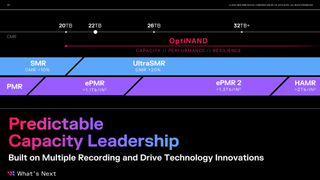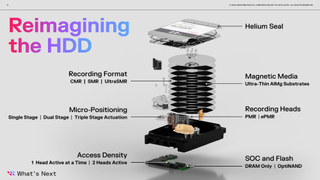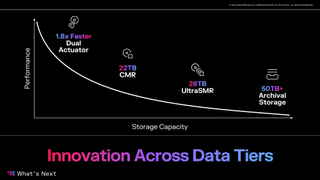Western Digital Shares Roadmap: 26TB Today, 50TB Tomorrow
Western Digital promises 32TB+ ePMR 2 HDDs in a few years.

Western Digital this week introduced its all-new 22TB and 26TB capacity hard drives, which use conventional magnetic recording (CMR) and the so-called Ultra SMR technology, respectively, and shared details about its future roadmap at its Investor Day event.
The company said that its 2nd Generation energy-assisted perpendicular magnetic recording (ePMR 2) technology will enable it to build 32TB+ HDDs in the next few years, but that heat-assisted magnetic recording (HAMR) will be required to hit capacities of 40TB to 50TB. Interestingly, Western Digital also talked about 50TB products for archival applications that are 'just around the corner.'
ePMR 2: 24TB ~ 30TB+ HDDs
Several years ago Western Digital said it would use microwave-assisted magnetic recording (MAMR) technology to enable the next generations of its hard drives, but eventually it discovered that a much simpler ePMR technology could do the job, which is why MAMR sidelined. Over time Western Digital ceased mentioning MAMR publicly and has now removed any mention of MAMR from its plans.

Western Digital says ePMR 2 will power its hard drives with capacities from 24TB to 32TB and higher in the coming years. Slides from Western Digital's presentations at its Investors Day conference do not directly mention availability timeframes for 30TB+ ePMR 2-based HDDs. To get to higher capacities Western Digital will need HAMR technology, which is set to arrive in 2026 for Western Digital, so we can speculate that 30TB+ ePMR 2 hard drives will become available before that.

It is necessary to note that while technologies like ePMR 2 and HAMR will increase areal recording density for HDDs, there will also be other ways for Western Digital to increase hard drive capacities. Shingled magnetic recording (SMR) in its regular or 'UltraSMR' form increase capacity by 10% to 20%, but there are more ways to boost capacity of an HDD.

Across the Board Innovations
To build higher-capacity HDDs, Western Digital not only has to adopt new magnetic recording methods, it also has to implement a host of technologies. The company's 3.5-inch 22TB Ultrastar DC HC570 HDD is based on an all-new 7200 RPM-class helium-sealed platform that integrates 10 ultra-thin AlMg platters, each with a 2.2TB capacity, as well as ePMR write heads that change coercivity of magnetic media with energy assistance, plus two-dimensional magnetic recording (TDMR) read heads that can reliably read data from very thin tracks. By contrast, Western Digital's 20TB CMR HDD uses nine platters. The company's latest drives also use triple stage actuation and Western Digital OptiNAND technology to further increase usable capacity (by storing service data on NAND flash).

Western Digital's 22TB HDD uses conventional magnetic recording technology and looks to be drop-in compatible with existing infrastructure, and will be available to operators of exascale datacenters, server makers, and channel resellers this summer. Eventually the manufacturer plans to ship 22TB WD Purple Pro, WD Red Pro, and WD Gold HDDs.
Stay on the Cutting Edge
Join the experts who read Tom's Hardware for the inside track on enthusiast PC tech news — and have for over 25 years. We'll send breaking news and in-depth reviews of CPUs, GPUs, AI, maker hardware and more straight to your inbox.
But while Western Digital's 22TB hard drive is a sophisticated device, the 26TB Ultrastar DC HC670 UltraSMR HDD is considerably more complex. On the hardware/platform side it is very similar to the 22TB model (i.e., it uses 10 platters, triple stage actuators, energy-assisted recording, TDMR read heads, OptiNAND, etc.), but it uses Western Digital's so-called UltraSMR technology, which uses more shingled bands and fewer CMR bands to deliver ab 18% more usable storage space. To ensure that data recorded on adjacent shingled tracks is stored safely despite increased adjacent tracks interference (ATI), Western Digital introduced a special error correcting code (ECC) technology that is supported by its HDD controller.


Western Digital's UltraSMR provides a more tangible capacity advantage than regular SMR (shingled magnetic recording) technology, but it also requires the company's partners to tailor their software for UltraSMR and avoid rewriting data or making many random writes.
50TB Archival Drives?
One of the most intriguing parts of Western Digital's presentation was about its 50TB drives that are just around the corner.
"I won't say too much about the specifics of our archive drives and storage units that we are building and co-engineering [with] a few customers," said Ashley Gorakhpurwalla, executive vice president and general manager of Western Digital's HDD business. "As a matter of fact, they might not become publicly available as they are specialized differentiated products for certain large customers, but we see with our roadmap and our development, [that] we are right around the corner from delivering 50TB capacity units."

In fact, Western Digital's EVP did not call the 50TB drives hard drives and the slide that he demonstrated did not show any rotating media. Meanwhile, since Ashley Gorakhpurwalla is the head of the company's HDD business unit, these specialized products could indeed be hard drives that are only available to select customers with highly custom software and hardware.
Given how many technologies Western Digital uses for its HDDs today (ePMR 2, UltraSMR, OptiNAND, 10+ platters, custom controllers), it could probably build a bespoke archival solution that could store 50TB of data — the only question is whether it would use some sort of compression and/or come in a standard form-factor.
Summary
Demand for high-capacity hard drives from operators of hyperscale cloud datacenters is only going to increase in the coming years. To meet demands from its customers going forward Western Digital is adopting not only new magnetic recording technologies (ePMR, ePMR 2, etc), but also other methods (OptiNAND, UltraSMR, etc).
With its 22TB and 26TB HDDs, Western Digital has the industry's highest-capacity hard drives and is ahead of Seagate and Toshiba. Meanwhile, the company's roadmap no longer mentions new HDD capacity points tied to an availability timeframe, which may indicate that, while Western Digital has a solid technology portfolio, it doesn't want to make any promises next-gen HDD launch windows.

Anton Shilov is a Freelance News Writer at Tom’s Hardware US. Over the past couple of decades, he has covered everything from CPUs and GPUs to supercomputers and from modern process technologies and latest fab tools to high-tech industry trends.
-
Kamen Rider Blade They need to go beyond "Dual Actuator" where one arm stack is split into 2x independent moving arms.Reply
They need to go towards "Quad Actuator" where there are 2x arm stacks with 2x independent moving arms per stack.
Imagine the bandwidth throughput you can get.
Most Popular





